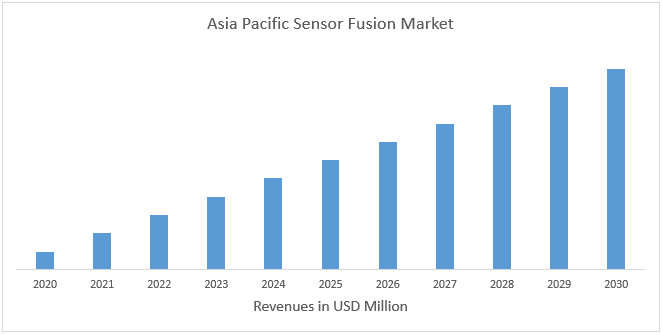Emergence of Digitalization in Various End-User Industries, Growing Automotive & Aviation Industry Propelled the Growth of the Sensor Fusion Market in the Asia Pacific Region!
Author: Himanshu Patni
29 July 2023
The Asia Pacific region would exhibit the highest CAGR during 2023-2030 owing to the growing demand for autonomous vehicles, the emergence of digitalization in countries such as India and China, and the increasing investments to build smart cities. One of the primary factors fueling the growth of the Asia Pacific sensor fusion market is the increasing demand for autonomous vehicle sales in the region particularly in Japan, and China. The aviation industry has also undergone a revolution and digitalization has disrupted traditional aviation approaches, improving protection, performance, and passenger experience. Sensor fusion performs an important function right here as well. By way of merging data from numerous sensors, along with weather radars, avionics systems, and surveillance systems, airways can make informed decisions, detect potential dangers, and improve standard situational recognition. For instance, in 2023, Air India, the Tata Group-owned airline recently placed a massive order of 470 aircraft with plane makers Airbus and Boeing in a deal value of USD 68 billion. Moreover, the rise of smart cities within the Asia Pacific region has fueled the demand for sensor fusion technology. Smart city tasks goal to leverage digitalization and IoT (Internet of things) to beautify urban residing, sustainability, and mobility. Sensors play a critical role in gathering information about site visitors, air quality, infrastructure, and public safety. By using data from diverse sensors, authorities can gain real-time insights, optimize aid allocation, and improve the overall excellent of life in these cities. For instance, in February 2023, the Indian government allocated USD 1717.36 million towards its smart cities mission and announced the establishment of an urban infrastructure development fund for smaller towns and reforms in urban planning and property tax to improve sustainability. Therefore, the Asia-Pacific region witnessing significant growth in the fusion sensor market and is expected to act in the same fashion in the forecast period.
Access sample report (including graphs, charts, and figures):https://univdatos.com/report/sensor-fusion-market/get-a-free-sample-form.php?product_id=42948
Further, the Asia Pacific Sensor Fusion Market is expected to grow at a strong CAGR during the forecast period (2023-2030). Asia Pacific is anticipated to emerge as the fastest-growing sensor fusion market primarily owing to the surge in the production of autonomous and semi-autonomous vehicles. Furthermore, the development of smartphone manufacturers in countries such as India, China, and Japan has massively created the demand for the sensor fusion market.
For a detailed analysis of the Global Sensor Fusion Market browse through– https://univdatos.com/report/sensor-fusion-market/
Based on type, the market is divided into radar sensors, image sensors, IMU, temperature sensors, and others. The radar segment dominated the market in 2022 and is expected to show the same trend in the forecast period. Radar sensors are usually used in object detection and tracking in aviation and other industries especially in extreme weather conditions where visibility is very low. Moreover, the radar sensor is precisely used in the autonomous vehicle to detect and track pedestrians, and other obstacles. Therefore, the rising aviation industry and the burgeoning adoption of autonomous vehicles cater to the demand for fusion sensors.
Based on technology, the market is segmented into mems and non-mems. The mems is currently the leading segment and is expected to dominate the segment in the forecast period. The major factor for the growth of the segment is the rising demand for microelectronic devices due to the increasing demand for digital technologies in today’s era, the growing demand for automation in various end-user industries, and advancement in technologies. Additionally, MEMS sensors are produced using the batch fabrication process and leveraging semiconductor techniques.
FIG. 1 Asia Pacific Sensor Fusion Market Revenue (2021-2030)- USD Mn

Based on industry vertical, the market is bifurcated into automotive, healthcare, electrical and electronics, military & and defense, and industrial. Among these, the automotive segment has dominated the market in 2022 and is expected to follow the same pattern in the forecast period. The major factors behind the growth of the segment are the ongoing demand for advanced driver assistance systems (ADAS). The automotive industry has invested heavily in ADAS technology amid growing demand for improved vehicle safety and autonomous driving capabilities. Sensor fusion plays a vital role in ADAS by integrating data from ultrasonic, radar, camera, and lidar sensors. This integration improves data accuracy and reliability, enabling more complex ADAS functions to be developed.
Global Sensor Fusion Market Segmentation
Market Insight, by Type
- Radar Sensor
- Image Sensor
- IMU
- Temperature Sensor
- Others (Pressure Sensors, Light Sensors, and others)
Market Insights, by Technology
- MEMS
- Non-Mems
Market Insights, by Industry Vertical
- Automotive
- Healthcare
- Electrical and Electronics
- Military & Defence
- Industrial
Market Insight, by Region
- North America
- U.S.
- Canada
- Mexico
- Rest of North America
- Europe
- Germany
- UK
- France
- Italy
- Spain
- Rest of Europe
- APAC
- China
- Japan
- India
- South Korea
- Rest of APAC
- Rest of the World
Top Company Profiles
- Robert Bosch GmbH
- ZF Friedrichshafen AG
- Continental AG
- NXP Semiconductor
- Infineon Technologies
- Denso Corporation
- Renesas Electronics Corporation
- Aptiv
- TDK Corporation
- ST Microelectronics
Get a call back
